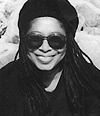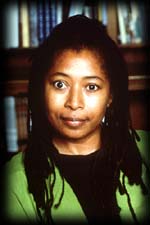Text Only Version
Page Four: Resurrecting Zora
Note: Click on dates to scoll to the page below. This page may contain reference links to other websites. If your browser does not support the "Back" function please write down this referring web address: "https://members.tripod.com/chrisdanielle/alicebio4.html"

Time Line
- 1970: While researching for a short story on voodoo, Alice discovers the folk stories of Zora Neale Hurston.
- 1972: Alice moves with her daughter Rebecca to Massachusetts where she is taught at Wellesley College a course on African-American Women Studies, the first class of its kind in the country. She also teaches classes at the University of Massachusetts in Boston.
- 1973: Alice and a friend, Charlotte Hunt, fly down to Eatonville, FL, Zora Neale Hurston's birthplace and places a tombstone on her unmarked grave.
- 1973: Alice's second volume of poetry, Revolutinary Petunias and Other Poems is published, along with her first short story collection, In Love and In Trouble: Stories of Black Women.
- 1974: Alice Walker moves back to New York where she becomes a contributing editor at Ms. Magazine. Her book Langston Hughes: American Poet is published.
- 1976: She and her husband Mel Leventhal divorce amicably.
- 1976: Her novel Meridian is published. Critics hail it as one of the best novels to come out of the Civil Rights movement.
- 1976: Alice begins work on her third work of poetry Goodnight Willie Lee, I'll See You in the Morning.

BIOGRAPHICAL SUMMARY
In all of her literature courses during college, Alice was not taught a single work written by an African-American. So, as a writer- in-residence at Jackson State College in Mississippi, Alice decided to audit a class that is being taught by poet and author, Margaret Walker. It is in Margaret Walker's class that Alice first learned about an African-American woman writer who would profoundly influence her, Zora Neale Hurston.
Zora Neale Hurston was considered a leading contributor to the Harlem Renaissance movement in the 1920s. She had studied anthropology under the famous anthropologist, Franz Boaz. Hurston was a serious cataloger of African-American folk stories, dialect, and religious practices. She had written an autobiography, four novels, and two books of folklore during her lifetime.
In late 1970, while Alice is writing a story on voodoo that she plans to publish, "The Revenge of Hannah Kemhuff," she decided to thumb through the books of Zora Neale Hurston for use as possible resources. Alice picked up and read a copy of Hurston's book Mules and Men. She enjoyed the book so much, she decided to read the stories aloud to family members and anyone else who would listen. As a result, her family members and listeners say they rediscovered some of the old folk stories that had been lost to them as children.
Alice continued to read all of Zora Neale Hurston's books. She read Zora's book, Their Eyes Were Watching God. Alice loved the novel so much she considered this as the single most important book she's ever read, along with Jean Toomer's book, Cane. She found Zora Neale Hurston's stories warm and folksy and as evidence of "racial health" in the Black community. In Hurston's books Alice Walker found that African-Americans were shown as being complete and complex individuals undiminished by the negative stereotypes or characterizations depicted by society.
Alice also found a commoradity with Zora Neale Hurston. Hurston, like herself was continuously flagged by critics throughout her life. Hurston was often criticized for her lifestyle and mode of dress. And like many of Alice's critics, Hurston's critics did not actually read her books. Alice saw Zora Neale Hurston's brave example as an inspiration to continue to work and speak her mind, in spite of what her critics would say about her.
Back to the Top
Pictured: Zora Neale Hurston
In 1972, Alice left Mississippi with her daughter Rebecca to move to Cambridge, Massachusetts where she was hired to teach at the all-women's school of Wellesley College. There, Alice created a class for the study of African-American Women Writers. This is the first-known class of its kind in the country. She then accepted a job to teach at the University of Massachussetts in Boston. In 1973, she published her second book of poetry, Revolutionary Petunias and Other Poems. This is nominated for a National Book Award. It eventually wins the Lillian Smith Award from the Southern Regional Council. She also published her first short story collection In Love and In Trouble: Stories of Black Women which received the Richard and Hinda Rosenthal Award from the American Institute Arts and Letters.
It is also in 1973, that Alice decided to make a trip down south with a friend, Charlotte Hunt, to Zora Neale Hurston's birthplace. Posing as Hurston's niece, Alice tried to uncover information that would lead her to Hurston's burial place. Through her interviews with some of the town locals who knew Hurston, she learned that Hurston died in a nursing home from a stroke in 1960. She also discovered that Hurston is buried in the Garden of Heavenly Rest on Seventeenth Street in Eatonville, Fla. When Alice and her friend arrived at the cemetery it was in a state of disarray. They had to clear the cemetery where Hurston was buried of weeds and other vegetation in order to find her gravesite.
Out of her own pocket, Alice paid to have a gravestone marker created in honor of her inspiration which reads:
Zora Neale Hurston
"A Genius of the South"
Novelist Folklorist
1901 - 1960
After it was erected, she placed flowers on the gravesite of her mentor and inspiration in memorium. Ironically, it was during this very same year that Alice's own father died.
Back to the Top
In 1974, Alice's book, Langston Hughes: American Poet was published, which was a reader whose intention was to teach children about the legendary Harlem Renaissance Poet. She was also hired as a contributing editor for Ms. Magazine. Alice moved to New York City with her husband and her daughter, Rebecca. While living there, Alice worked only part-time at the magazine and dedicated the remainder of her time to her writing.
Meridian, which was Alice's second novel, was published in 1976. Although the book had its detractors, overall the book came out to great critical acclaim. Her novel was one of the first books based on the lives of women in the Civil Rights struggle. Although Alice was achieving critical success in the public limelight, behind closed doors her marriage was falling apart. She and her husband, Mel Leventhal decided to divorce. The divorce was an amicable one and when they separated they decided to remain friends.
Alice described this as being a very difficult time in her life. Still reeling from the grief over death of her father and her divorce, Alice turned to writing to sustain her through the pain. She began work on a third work of poetry, Good Night Willie Lee, I'll See You in the Morning. After her poems were sent to her publisher, Alice began the genesis of what would be her third novel and most celebrated novel.
This page created, written and designed March 1999. Send your comments to the following e-mail address chrisdani@yahoo.com. Copyright April 7, 1999. None of the material on this website can be used without the permission of the webmistress.
Available URL: "https://members.tripod.com/chrisdanielle/alicebio4.html"







